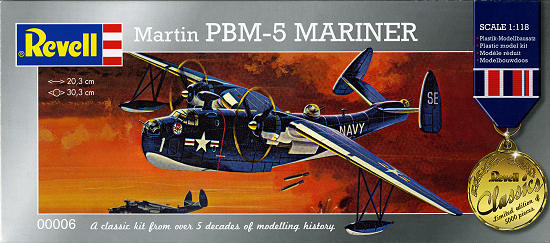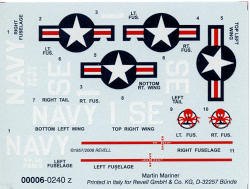
Revell 1/118 PBM-5 Mariner
| KIT #: | 00006 |
| PRICE: | $20.35 from GreatModels |
| DECALS: | One option |
| REVIEWER: | Scott Van Aken |
| NOTES: | No 'S' stand |

| HISTORY |
In 1937, the Glenn L. Martin Company designed a new twin engined flying boat to succeed its earlier Martin P3M and supplement the Consolidated PBY, the Model 162. It received an order for a single prototype XPBM-1 on 30 June 1937. This was followed by an initial production order for 21 PBM-1 aircraft on 28 December 1937.
To test the PBM's layout, Martin built a ⅜ scale flying model, the Martin 162A Tadpole Clipper with a crew of one and powered by a single 120 hp (90 kW) Chevrolet engine, this flying in December 1937. The first genuine PBM, the XPBM-1, flew on 18 February 1939.
The aircraft was fitted with five gun turrets and bomb bays that were in the engine nacelles. The gull wing was of cantilever design, and featured clean aerodynamics with an unbraced twin tail. The PBM-1 was equipped with retractable wing landing floats that were hinged inboard, like the Catalina. The PBM-3 had fixed floats, and the fuselage was three feet longer than that of the PBM-1.
The first PBM-1s entered service with Patrol Squadron FIFTY-FIVE (VP-55) of the United States Navy on 1 September 1940. Prior to the outbreak of World War II, PBMs were used (together with PBYs) to carry out Neutrality Patrols in the Atlantic, including operations from Iceland. Following the Japanese Attack on Pearl Harbor, PBMs were used on anti-submarine patrols, sinking their first German U-Boat, U-158 on 30 June 1942. In total, PBMs were responsible, wholly or in part, for sinking 10 U-Boats during World War II. PBMs were also heavily used in the Pacific, operating from bases at Saipan, Okinawa, Iwo Jima and the South-West Pacific.
The United States Coast Guard acquired 27 Martin PBM-3 aircraft during the first half of 1943. In late 1944, the service acquired 41 PBM-5 models and more were delivered in the latter half of 1945. Ten were still in service in 1955, although all were gone from the active Coast Guard inventory by 1958 when the last example was released from CGAS San Diego and returned to the US Navy. These flying boats became the backbone of the long-range aerial search and rescue efforts of the Coast Guard in the early post-war years until supplanted by the P5M the HU-16 Albatross in the mid-1950s.
PBMs continued in service with the US Navy following the end of World War II, flying long patrol missions during the Korean War. It continued in front-line use until replaced by its direct development, the P5M Marlin, with the last USN squadron equipped with the PBM, Patrol Squadron FIFTY (VP-50), retiring them in July 1956.
The British Royal Air Force acquired 32 Mariners, but they were not used operationally, with some returned to the United States Navy. A further twelve PBM-3Rs were transferred to the Royal Australian Air Force for transporting troops and cargo.
The Royal Netherlands Navy acquired 17 PBM-5A Mariners at the end of 1955 for service in Netherlands New Guinea. The PBM-5A was an amphibian plane with retractable landing gear. The engines were 2,100 hp (1,566 kW) Pratt & Whitney R-2800-34. After a series of crashes, the Dutch withdrew their remaining aircraft from use in December 1959.
| THE KIT |
 To those of a certain age, this is an old friend. Initially released in the mid/late 1950s as part of Revell's large catalogue of 'box scale' kits. This one was initially designed to fit on the 'S' stand and the ball for the fuselage is still part of the sprues, though sadly, the stand is not included.
To those of a certain age, this is an old friend. Initially released in the mid/late 1950s as part of Revell's large catalogue of 'box scale' kits. This one was initially designed to fit on the 'S' stand and the ball for the fuselage is still part of the sprues, though sadly, the stand is not included.
Everything else is there, however, and despite its advanced age, the molding looks pretty good. Understandably, there is flash and the medium blue plastic is still festooned with rivets as its major detail suite. Of course, back then, rivets were expected and considered to be the epitome of detailing, just like we expect engraved panel lines. Interestingly, rivet detailing is probably more prototypical than engraved panel lines, but I digress.
The kit is designed for a stand as there is no beaching gear. In place of the S stand, there is a small blue plastic one that is quite adequate and is something I've seen in a similar vein o n some other old Revell flying boat kits. Options are few and limited to having the engine nacelle bomb bays open or closed. Four bomb shapes are provided for the open option. The clear bits for the turrets and windscreen look fairly good, though I'm sure they will require a bit of fiddling to get fit and painted.
n some other old Revell flying boat kits. Options are few and limited to having the engine nacelle bomb bays open or closed. Four bomb shapes are provided for the open option. The clear bits for the turrets and windscreen look fairly good, though I'm sure they will require a bit of fiddling to get fit and painted.
Instructions are not like what originally was provided. This is Revell AG so there are the standard instruction drawings and Revell paint references. Decals are the same that have ever been packaged with this kit. I don't know the unit, but the aircraft is shown painted dark sea blue over white. I have my doubts about the white part of things and suspect that it should be overall dark sea blue. At least with the reissue you get fresh decals and these are 'made in Italy' so should provide no problems at all.
| CONCLUSIONS |
Now I realize the 1/118 is not a standard scale, but then those who build this kit are not concerned about scale, only having a Mariner kit. Though I think that Mach 2 have done an injected Mariner in 1/72, this one has to be easier to build and is probably more accurate in shape!
| REFERENCES |
http://en.wikipedia.org/wiki/PBM_Mariner October 2009
You can find this and many other neat kits at GreatModels If you would like your product reviewed fairly and fairly quickly, please contact the editor or see other details in the Note to Contributors.